We advise on problems from
Kidney stone
Learn more about kidney stones and their treatment.
What are kidney stones?
Kidney stones, also called urolithiasis, are stones that most often form in the kidneys and can then become lodged in the kidney cavity or ureter, completely or partially blocking the flow of urine. So-called kidney gravel is simply the term for smaller kidney stones. Urine naturally contains salt and minerals, but when the urine becomes oversaturated with these, e.g. calcium, oxalic acid and phosphate, there is a risk that these will crystallize and become stones.
Jump to section [Vis]
Types of kidney stones
- Calcium oxalate stones: These occur if you have too much calcium (lime) and oxalate in your urine.
- Calcium phosphate stones: These are made up of calcium and phosphate and form when the urinary environment becomes too basic or alkaline.
- Uric acid stones: These stones form when you have too much uric acid in your urine.
- Struvite stones: These stones can form as a result of a urinary tract infection. These stones are often made up of a combination of magnesium, ammonium, and phosphate.
- Cystine stones: These stones form if you have a genetic disorder called cystinuria, where the body excretes too much cystine.
Source: minmedicin.dk
Causes of kidney stone formation
Kidney stones form when the content of salts and minerals in the urine becomes too high, i.e. supersaturated and therefore not dissolved optimally. In many people with kidney stones, no cause is found, but the following factors can increase the risk of kidney stones:
Sparse fluid intake
The risk of kidney stones can be significantly reduced by drinking plenty of fluids to make the urine less concentrated. Too little fluid intake can result in not all salts and minerals dissolving, which can increase the risk of crystallization and stone formation. If you have a tendency to form kidney stones, you should drink fluids, including water, low-calorie fluids or similar, in quantities such that you produce at least 2 liters of liquid urine per day. You can measure the amount of urine or simply make sure that the urine is light and clear after each urination.
Imbalance in the diet
Diet can also influence the risk of kidney stone formation, especially if you do not eat a varied diet. Intake of too acidic (low pH) or too alkaline (high pH) foods can lead to shifts in the pH of the urine and thereby increase the risk of the formation of various types of kidney stones. For example, you should only consume oxalic acid in modest amounts if you tend to form the so-called calcium oxalate stones. High levels of oxalic acid are found, for example, in rhubarb, nuts and chocolate.
Studies have also shown that it can help to eat less meat and instead increase your intake of fiber, grains, fruits and vegetables.
In addition, it is important to save on your intake of table salt, as excessive intake can increase the excretion of calcium (lime) from the kidneys and thereby increase the risk of calcium stones.
Acidic urine (low pH) can be linked to lifestyle diseases such as obesity and diabetes and lead to the formation of so-called uric acid stones.
Urinary tract malformations
Congenital narrowings and/or other abnormalities in the urinary tract can cause stones to become lodged more frequently and to a greater extent. Long-term infections in the urinary tract can also cause narrowings, which can increase the risk of stones becoming lodged.
Urinary tract infections
Chronic infection of the urinary tract with urease-producing microorganisms, including Proteus, Pseudomonas, and Klebsiella, can lead to the formation of stones, which are often very large. These are rare causes of kidney stones.
Congenital enzyme defect
Enzyme deficiency resulting in increased excretion of the amino acids cystine, ornithine, lysine, and arginine in the urine can lead to stone formation. This is a rare cause of kidney stone formation.
Sources: lægehåndbogen.dk, patienthåndbogen.dk, minmedicin.dk

Symptoms of kidney stones
Kidney stones may be asymptomatic, especially with smaller stones or gravel, but can also cause kidney stone attacks, which typically consist of sudden onset, often intense and intermittent pain.
The pain is most often located just below the lower rib cage on the flank or in the back. The pain can radiate down to the groin and genitals, and is frequently accompanied by nausea and vomiting.
The pain can be intense and cause you to wander around during the attacks, but can also be less intense and more like a discomfort/grunt in the kidney area without radiation.
In some cases, you can see blood in the urine, but most often the blood will only be microscopic and can only be detected if you examine the urine with a urine stick. The reason for blood in the urine is that the stones will make small tears in the mucous membrane. In addition to blood, some people will also experience a burning sensation when urinating and a constant urge to urinate, which should give rise to a simultaneous examination for a urinary tract infection.
In the event of severe, intermittent pain in the flank or back, often accompanied by nausea and vomiting, or in the event of simultaneous fever and suspicion of urinary tract infection, your doctor or emergency physician should be contacted immediately, as kidney function may be at risk and there is an increased risk of developing blood poisoning.
Source: patienthåndbogen.dk
Diagnostic of kidney stones
You will always review your medical history and symptoms, which can often lead to suspicion of the diagnosis. If you have had kidney stones in the past, the risk of new stones forming is high. In addition, a physical examination will often reveal tenderness around the kidney area and in the flank.
The urine can be examined with a urine dipstick which will often show blood, but can also show signs of infection. Blood tests can show signs of infection and give an impression of whether kidney function is affected.
Ultrasound scanning of the kidneys will only be able to detect kidney stones in some cases, but the examination is good for detecting whether the drainage of urine from the kidney is affected, as the urinary tract and kidney may then be enlarged. In addition, ultrasound is always used first in children or pregnant women suspected of having kidney stones.
However, if kidney stones are suspected, a CT scan is the best examination as it can accurately identify the stones, their number, size and location. The scan can also reveal the condition of the kidneys and urinary tract, which may be affected by stones, but also if there is another disease.
Source: patienthåndbogen.dk

Treatment of kidney stones
Initial treatment of acute kidney stone attacks is pain relief. Most kidney stones are small, i.e. less than 3-5 mm, and pass spontaneously, but if the stone becomes lodged and if the kidney is affected or if there is a concurrent urinary tract infection, the urinary tract must be urgently relieved in hospital, which is done by inserting a catheter into the kidney. If stones do not pass on their own, you can choose to remove them, for example by shock wave stone crushing or via endoscopy. The choice of treatment is assessed based on number, size, location and type.
The choice of painkilling treatment is drugs in the NSAID group as they can significantly reduce pain and facilitate the stone passing on its own without the need for surgery.
If you have frequent stone attacks, it is a good idea to have painkillers at home, prescribed by your doctor. It is also important to get advice on fluid and dietary intake. Sometimes you may also be offered various forms of preventive medicine if you frequently form kidney stones.
Disease course
As described above, most stones are less than 5 mm and will usually pass spontaneously. Two-thirds of stones pass spontaneously within 4 weeks, but stones that do not pass after 4-8 weeks usually require further treatment.
Preventing kidney stones
Many people with kidney stones will have new attacks and it is therefore important to prevent them where possible.
General, non-medical advice:
- Drink plenty of fluids, including water or low-calorie drinks, to ensure normal urine production, i.e. approximately 1 liter of urine per day. If you have a tendency to form kidney stones, urine output should be increased to 2-3 liters per day.
- Eat a varied diet and increase your intake of fiber, grains, vegetables, and fruit. Reduce your intake of animal protein, oxalic acid (rhubarb, asparagus, spinach, nuts, and chocolate) and purine-rich foods (organ meats, sardines, anchovies, and beans). Be cautious with sugar, refined carbohydrates, and table salt.
- Exercise and move. Prolonged immobilization can increase the risk of kidney stones, just as lifestyle diseases such as obesity and diabetes can increase the risk. Exercise improves the circulatory and lymphatic systems, and can contribute to weight loss.
- Reduce stress levels in the body to indirectly improve body function and reduce the risk of lifestyle diseases.

Complications associated with kidney stones
Complicated kidney stones, where there is, for example, concomitant fever, infection and/or enlarged renal pelvis (hydronephrosis), can, if untreated, lead to blood poisoning and/or loss of kidney function. However, the vast majority of kidney stones pass spontaneously and kidney stones are rarely the cause of chronic kidney failure.
In addition to the serious medical complications mentioned above, people with frequent and recurrent kidney stones can experience this as a very disruptive factor in their quality of life. It can cause fear of attending social events, traveling, etc., as the pain can occur acutely and be very intense. It is therefore important to focus on preventive factors to reduce the risk of recurrence.
Occurrence of kidney stones
Kidney stones are considered a common disease and the incidence is increasing, which is considered to be lifestyle-related.
Up to 20% of all men and 10% of all women will form kidney stones during their lifetime.
People in the age group of 30-50 years are most frequently affected and there is generally an increasing tendency for older children to develop lifestyle-related urinary tract stones. Recurrent cases of kidney stones are normal, with 50% having a new attack within 5 years and 70% within 20 years.
Source: lægehåndbogen.dk

What does the osteopath do?
Osteopathy is based on a holistic approach to the body and we strive to identify the underlying causes of health problems. This often involves the osteopath carrying out a comprehensive and thorough examination of the body, extending beyond the locally noticeable pain points.
Osteopaths have expertise in the nervous system, circulatory system, psychosocial aspects, musculoskeletal system and visceral area including gastrointestinal function and organ function. This gives the osteopath an in-depth understanding of how these systems function and work together in symbiosis.
The course of action
When a patient presents with pain, the first step is to obtain a medical history and specify symptoms. The osteopath then conducts a thorough examination of the affected structures and nearby areas that could potentially influence the problem and treats these.
If, after taking the medical history, symptoms and examination, it is deemed necessary, the patient is sent to a doctor for further evaluation.
Subsequently, an individualized treatment plan is drawn up between the osteopath and the patient. The treatment plan may, for example, contain recommendations and advice on lifestyle changes including diet and fluid intake, exercise and possibly also exercises if the osteopath considers this beneficial.

Often related pain

Side stitch
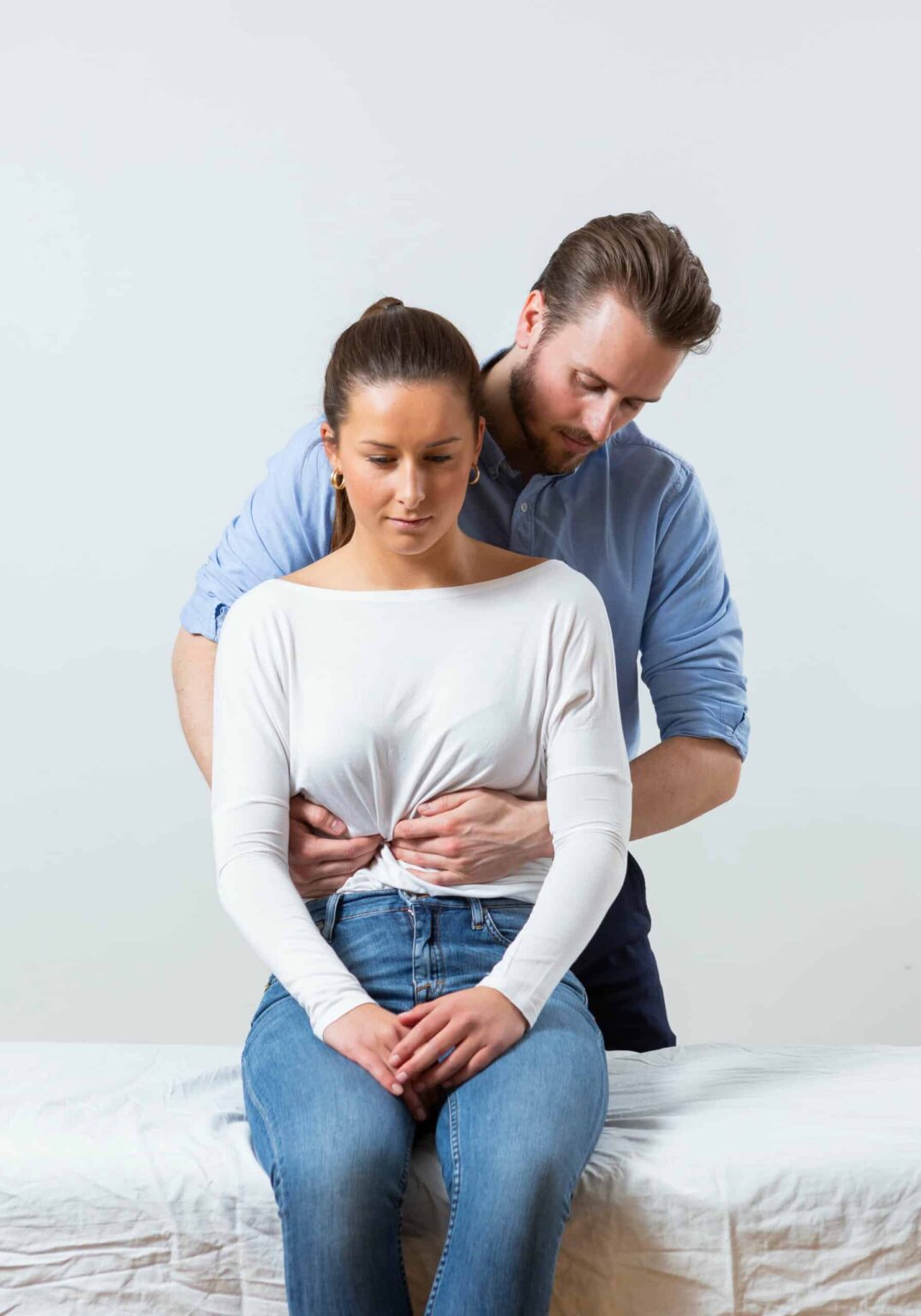
Hidden constipation
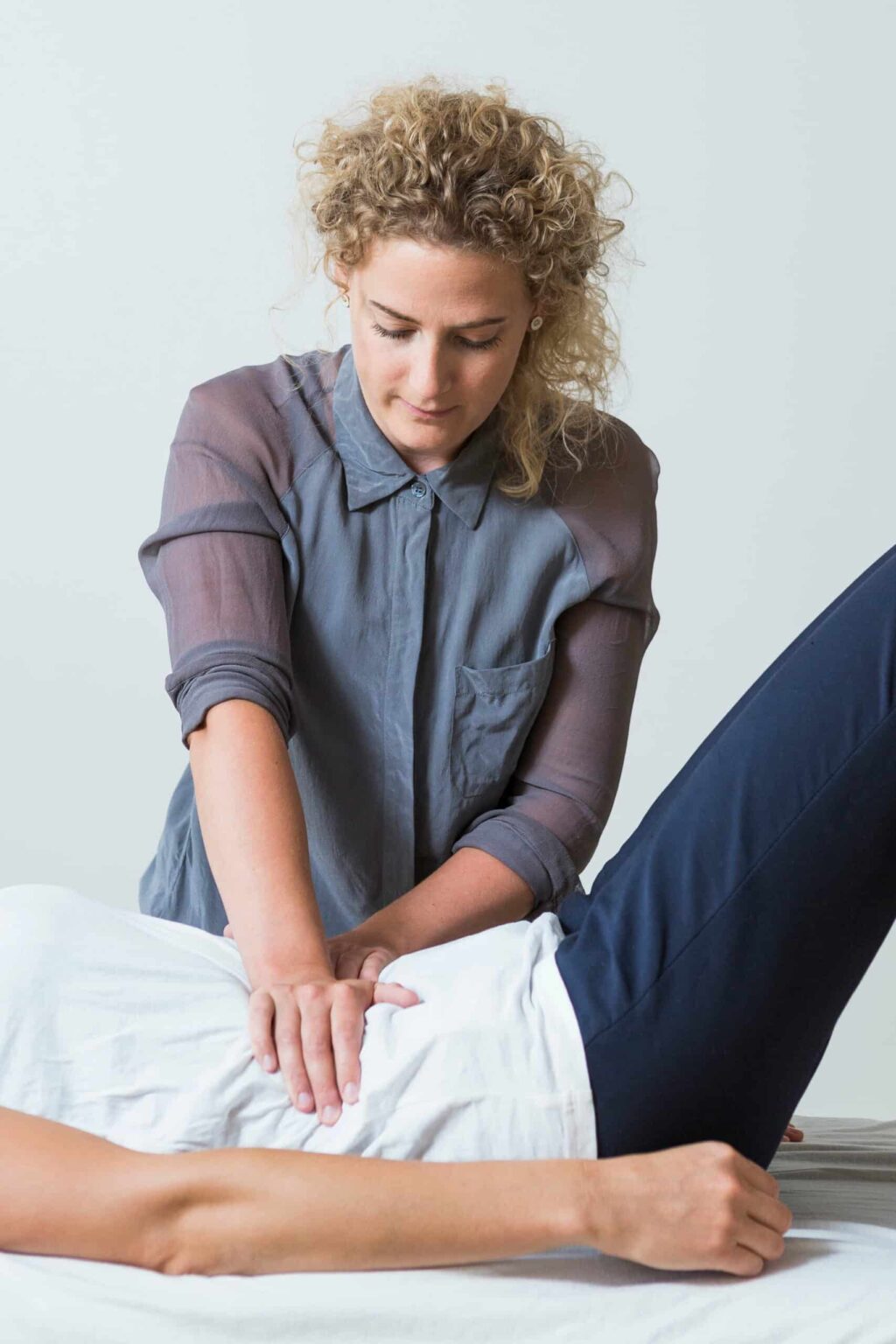
Urinary incontinence
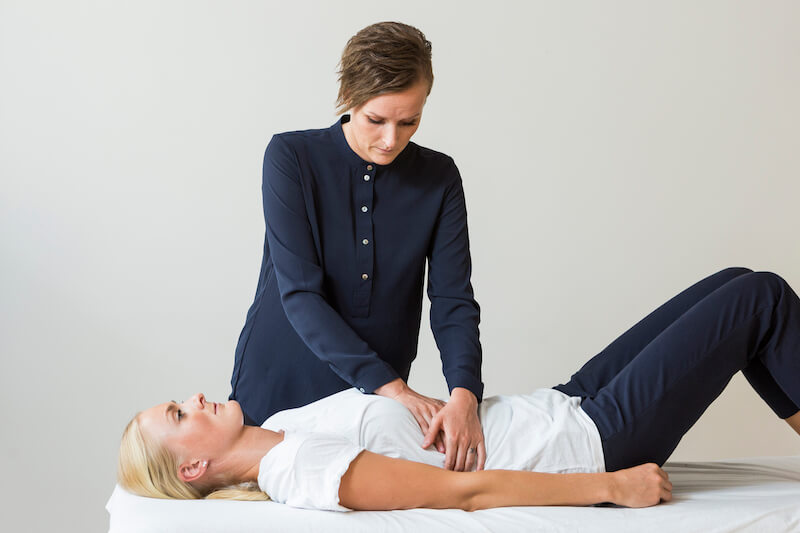
Celiac disease
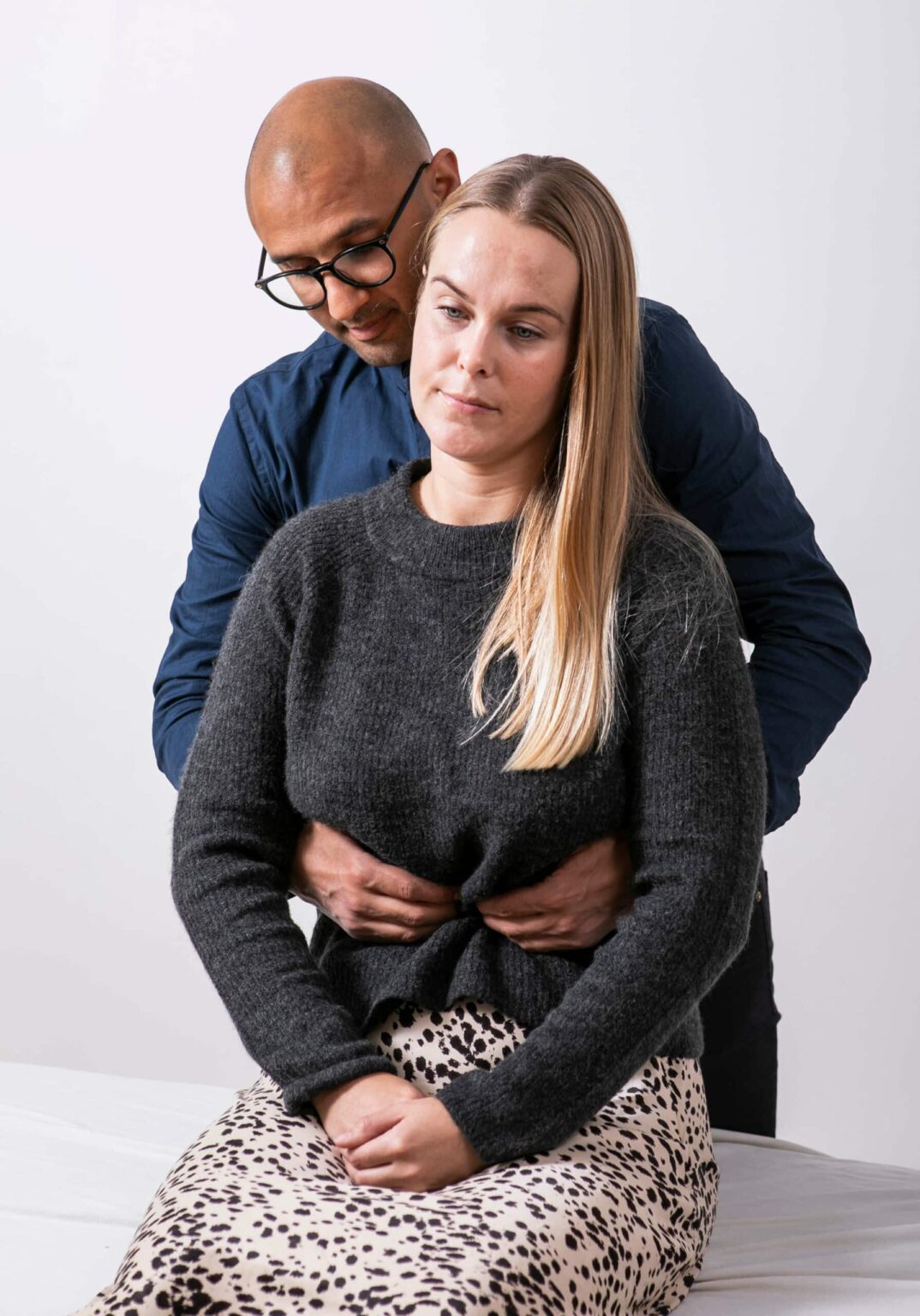
Ulcer

Hernia
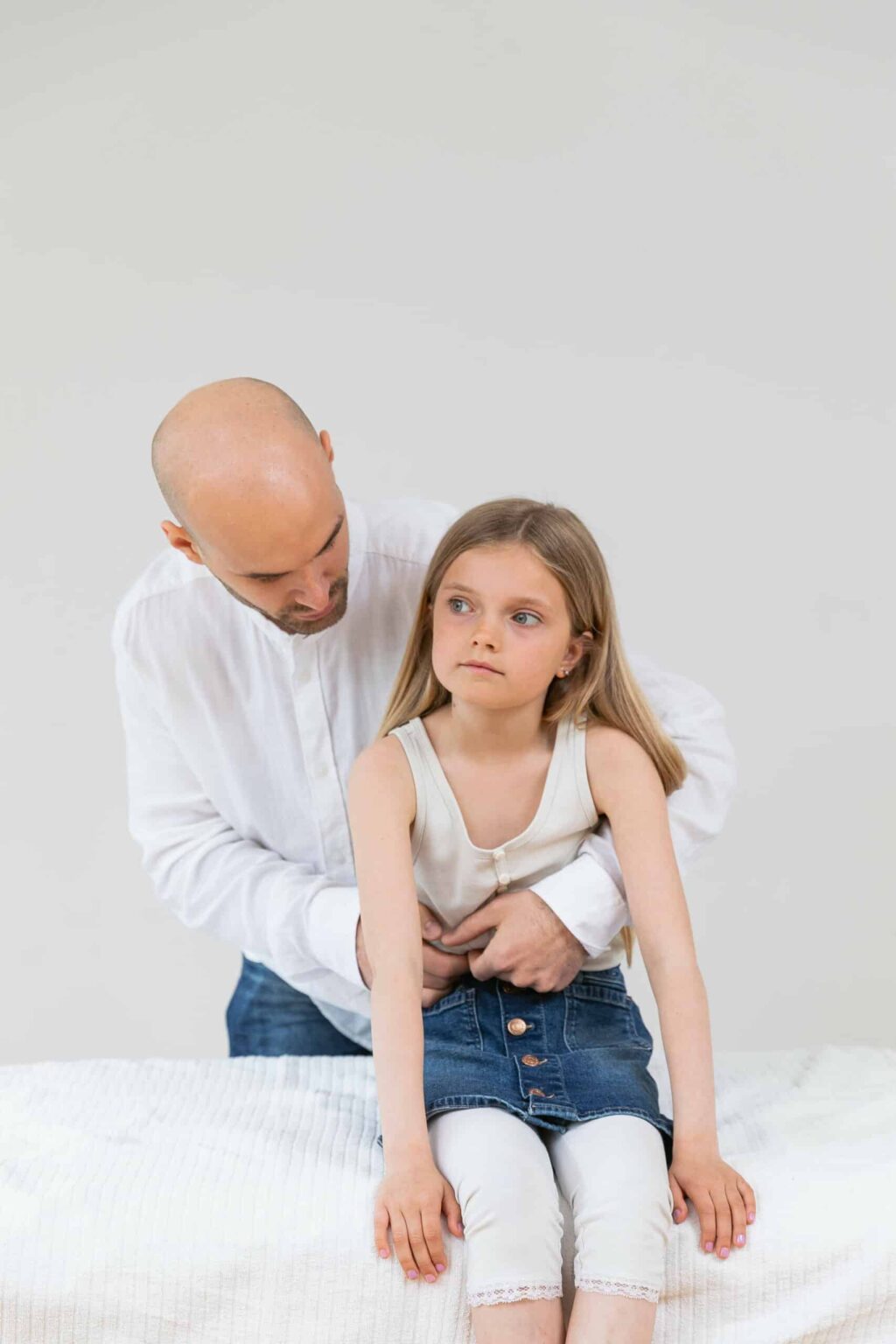
Lactose intolerance

